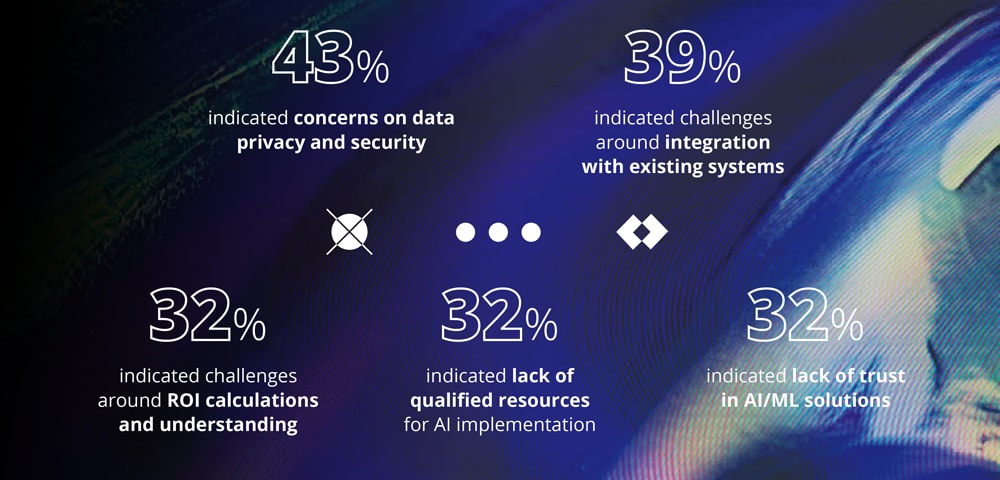The CMO’s guide to AI-powered marketing has been saved

Perspectives
The CMO’s guide to AI-powered marketing
Bridging the data divide to drive growth with AI
It’s no secret that personalization drives engagement. Today’s marketers also know that AI can power hyper-personalization. But many are struggling to effectively deploy AI marketing use cases—specifically for generative AI. Learn how a unified data ecosystem can amplify marketing strategies, and get the checklist to help you align with your IT leaders.
Understanding trends in AI marketing
For as long as marketers have honed their craft, they’ve understood that the organizations that know their customers and most effectively provide a personalized experience are the ones that can drive engagement, acquisition, and lifelong loyalty. In fact, research shows that a well-executed, hyper-personalized marketing strategy can deliver 8x the return on investment (ROI) and lift sales by 10% or more.1

Although marketers have relied on AI for some time now (maybe without even realizing it), the generative AI revolution is creating lots of excitement, numerous questions, and some trepidation about what new use cases could mean for marketing. For many organizations, it can still be very difficult to power a customer-centric and hyper-personalized AI marketing strategy that effectively links back to and connects with its customers.
To understand why, we surveyed a diverse group of marketing and IT leaders throughout the world to:
- Identify the use cases that marketers prioritize but struggle to execute
- Understand the common challenges that marketers experience with generative AI use case execution
- Define what marketers truly mean by “personalization” and “bringing their customer experiences to life”
When exploring the major challenges that organizations run into when implementing or using artificial intelligence/machine learning (AI/ML) to support their marketing use cases, our research uncovered an impactful collection of barriers.
What are the major challenges or barriers that your organization experiences when implementing and using AI/ML to support marketing and advertising use cases?

Barriers to AI marketing use cases
Although not an exhaustive list, several factors can contribute to these struggles and to an organization’s inability to overcome them.
While many organizations collect and store first-party data (and may combine it with second- or third-party data) to use in marketing campaigns, a lack of connectivity and interoperability between the data can be problematic and limit the impact of marketing analytics or activation efforts. Although not the only culprit, siloed or independent data systems often contribute to an organization’s lack of data unification and sharing, especially as the volume of collected data grows.
Based on our research, the top challenge organizations face when sharing data internally mirrors a top challenge associated with organizations using AI/ML for their marketing use cases: ensuring sufficient integrations or interoperability across data platforms.
There are many opportunities for marketers that are properly prepared to collect, process, and unify their data, particularly as the volume of gathered data grows. The ability to organize, access, and act on data is critical. Organizations that fail to address data management and unification requirements may find future data influxes to be more of a challenge than a chance for innovation.
Consumers have seemingly endless ways to research their interests, be inspired, or make a purchase. Conversely, marketers are dealing with a larger and more fragmented network of content channels to reach and engage people. This only amplifies the challenges that organizations and marketers must navigate—especially since, as research shows, people expect to be consistently treated as individuals across all of these channels. Organizations need to adapt to consumers’ changing interests in real time and serve up personalized content no matter where they are.
The slow and oftentimes complex orchestration of technologies within organizations can hinder the development of a project before it even starts.
In recent years, marketing teams have advanced their tech fluency. Since 2015, the fastest-rising skills mentioned in chief marketing officer (CMO) job postings are “key performance indicators (KPIs)” and “cloud solutions”—two areas that fit comfortably in the world of data and technology. Additionally, our research revealed that 72% of marketers possess either primary decision-maker or executive approver authority within their organizations when it comes to choosing marketing or data technology solutions.
This shift in skill set and responsibility has moved the focus of IT more toward system integration support and away from its traditional role as the primary enterprise technology decision-maker. For a while, this worked out, but over time and with the growth of first-party data and AI, conflicting priorities and perspectives between IT and marketing teams surfaced.
On the IT side, there’s a strong will to lead enterprise data and AI projects. It makes sense: This team oversees the organization’s data governance and security policies and often builds and trains AI/ML models. From the marketing team’s side, the desire to spearhead these data and AI projects stems from the fact that they are the ultimate consumers of these data assets (for instance, AI/ML model scores). Marketers need them to understand customers and build better marketing activation tactics, such as personalized content generation or an optimized media buying strategy.
Ultimately, this can lead to misalignment on the core objective(s) for an AI project, which can encourage both teams to continue to work independently. This can create an environment for AI adoption projects to sputter along or fail altogether as both teams struggle to agree on important project components, such as the business case, technical and financial requirements, and evaluation criteria.
Through our research, we continue to see that today in how teams within an organization believe first-party data is used to support an organization’s marketing use cases.
Ever-changing data privacy regulations require privacy leaders to constantly update and conform their organization’s data compliance and governance rules. Additionally, the expansive but often fragmented collection of data privacy laws propels many organizations to adopt internal policies that apply regulations, such as the California Consumer Privacy Act of 2018 (CCPA) or the General Data Protection Regulation (GDPR), across any consumer that interacts with the organization, regardless of that individual’s location. Additionally, heightened controls among internet browsers and hardware companies are impacting traditional data collection, and with these disruptions in gathering valuable data, marketers are facing significant disruption in how they drive business impact and measure ROI.
These changes can impact everything from campaign planning to post-campaign reporting, and they can affect the accuracy of third-party ad platforms and brand measurement systems. A marketer’s ability to target, measure, and understand its consumers is directly affected, which makes it vital that organizations align on and establish a privacy-centric approach to marketing.
This can be especially challenging for global brands that must untangle a web of regional, national, and international data privacy laws. Regardless of the complexity, owning and building a foundation of consented first-party data is crucial to AI-powered marketing. Our research indicates that high-growth companies are focused on using AI to support their marketing processes because AI is the business multiplier that can help organizations keep up with shifting consumer demands and gain necessary insights in an efficient and privacy-centric way.
As our research pointed out, many marketers are already cognizant of AI capabilities and the need to protect their customers’ data, but they may lack the necessary infrastructure, internal policies, or personnel to effectively use AI to support their marketing processes.
Marketing benefits from a unified data ecosystem combined with AI
Providing a superior customer experience is increasingly important for organizations, especially in today’s crowded marketplace. However, to meet or even exceed their customers’ needs, organizations should adopt a unified data ecosystem that integrates with their existing data systems, as well as harnesses the power of AI to create authentic customer experiences. This unified data ecosystem serves as the infrastructure that helps organizations take advantage of AI. In addition to positioning your organization to be successful with AI, you may realize the following benefits:
Make everyone an analyst
This concept of “everyone is an analyst” introduces a new way to work by making data and marketing analytics capabilities more accessible to all interested stakeholders. Essentially, it can empower an understanding of data at a superficial level by enabling marketers and other business users with the ability to create actionable insights through conversation. In turn, this can make insights commonplace and reduce the time needed for organizations to transform their vast amounts of data into insights and decisions.
Democratize storytelling
As part of our research, we discovered that 42% of marketers believe that generative AI use cases have the potential to significantly impact their marketing processes and are actively exploring its capabilities. For example, content guidelines and policies can be effective tools for marketers but are sometimes difficult to design and deploy. Content strategists can utilize generative AI to brainstorm and develop the content pillars that incorporate their organization’s mission, vision, and brand values. Additionally, generative AI can be an effective tool to enforce the brand guidelines that ensure an organization’s voice is consistent in content and community engagements across numerous platforms and channels.

How to create a unified data ecosystem and enable AI-powered marketing
Find an implementation approach that works for everyone
Perhaps the best place to start this journey is with the teams and individuals who will be responsible for the design, implementation, use, and support of the new data and AI capabilities. The objective here is to bring the marketing, business, and IT teams together to align on a data and AI implementation that fits with the organization’s culture, values, and growth strategy.
Build a data cloud
Ultimately, organizations can work with a data cloud provider to help design and drive use case testing that can quickly prove value without needing a new, full-scale enterprise system implemented. From that point, organizations can help build an appropriate business case, assess the output, and evolve.
Download the full paper to read in detail about all the strategies for unifying your data to supercharge your marketing efforts.
Looking for stronger business outcomes?
Read the full paper for a comprehensive list of steps you can take to reap the benefits of unified data and AI. See the CMO checklist for AI-powered marketing and the six questions to guide important governance conversations with your IT and data teams.
Get in touch
Recommendations
2023 Global Marketing Trends: Resilient seeds for growth
2023 Global Marketing Trends offers four trends that could help marketers better contribute to brand success and guide CMOs as they set priorities for 2023.
Marketing Science Services
Using data and technology to optimize advertising investments






